So, You want to influence others so that you can get more of what you want?
Use the Push Pull Influencing Model. But first, you need to understand it, and second, be able to use it. This article will help you.
Table of Contents
- What is the Push Pull Influencing Model?
- What is a Pull Influencing Style? (Appeal)
- What is a Push Influencing Style? (Assert)
- Which is Better – Push or Pull?
- Push and Pull Examples
- This is How Pushers and Pullers Act – Which One are You?
- Are You a Pusher or a Puller?
- Selling With a Push or Pull Style
- In Conclusion
1- What is the Push Pull Influencing Model?
It is a way to get someone to do what you want. Often defined as moving someone from position A (where they are now) to position B (where you want them to be), or as the ability to affect others attitudes, beliefs, and behaviours without using force or formal authority.
For example, you want a colleague to complete a spreadsheet by Thursday. You do not have the authority (you are not their boss), so you are relying on influence. This is either achieved by pushing (telling) them what you want. Or it can be achieved by pulling (asking) from them what they want – how they might achieve it. These two are the push pull influencing style in its very simplest terms.
In reality, the model goes much deeper with advanced push behaviours like Selling, Coercion, Logic, and Assertion. And advanced pull behaviours, like Expert, Educative, Building Bridges (Involvement), and Attraction (Emotion). This tool, when understood deeper, is much more powerful. Read on to find out more…
Just before you do read more, imagine if your influencing skills were zero. How would you perform at work? What would you achieve at home? Without this core soft skill – influencing – you would achieve very little. If you want to achieve more in life, you need to be able to influence people.
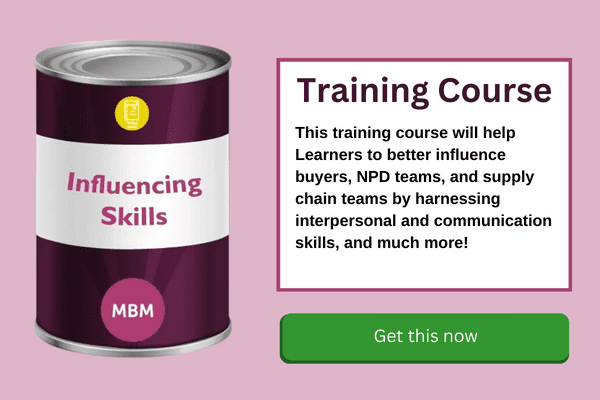
2- What is a Pull Influencing Style? (Appeal)
Ever met anyone who asks lots of questions? And actively listens to what you say? This is a ‘Puller’. This is the pull influencing style. This style is generally understood to be about motivating a person to see the possibilities. If we talk about ‘pull energy’ then it is all about drawing them towards what you want to achieve. There is more to it, but as a simple version, this is it.
A ‘style’ is a combination of behaviours that make up your style. For example, my leadership style might be labelled as democratic if I am always asking people their opinion, seeking counsel on every issue, and holding ballots. Similar can be said for influencing styles – it’s about all the everyday influencing behaviours we do that give us the influencing style.
Sticky Learning ® is 7 times more effective than 1-day training courses. Plus, you will get a Chain of Evidence proving your Return on Investment. Discover soft skills training that changes behaviours long term.

3- What is a Push Influencing Style? (Assert)
Ever met someone who tells you a lot about what’s going on with them? And wants you to listen to them? This is a ‘Pusher’. This is the push influencing style. Sometimes referred to as the ‘stick and carrot approach’ (Though I believe this labels it in a bad light when it can be positive and powerful), and generally understood to be about moving a person to another viewpoint using ‘push energy’. There is more to it, but as a simple version, this is it.
It is also possible to ‘move your energy away’ by doing neither push or pull, and simply not engaging, which can be done negatively or positively. In the negative, you might clam up and say nothing or give one-word answers. In the positive, you may say that you are withdrawing because you have very little to contribute.
4- Which is Better – Push or Pull?
They are both effective influencing styles. One style is not better than the other. It is not better to be a pusher or a puller. There are pros and cons to both. The challenge is not to become more of a push or more pull than you are now. The challenge is to know which influencing style to use in which situation to achieve what you want – push or pull.

Some experts believe that a single style per situation is more effective as using both styles in a situation cancels each other out. In my experience, I support this theory, but also on some rare occasions, it is possible to make both styles effective in one situation.
5- Push and Pull Examples; Negative & Positive and at Home & at Work
A Positive Pull at Work Example – Listening
For example, a customer is complaining. The most effective style would not be to begin sharing what you think because people want to first be heard when they are making a complaint. If you were to start talking and particularly talk over them to share your point of view (push), even though you may be so keen to help them, they are likely to become angrier.
The more effective one of the two in the influencing model is pulling. Actively listening, and asking questions when appropriate.
A Negative Pull at Work Example – Finding Blame
An error has been made in a spreadsheet which has meant that the report for the board is incorrect, having a significant impact on the decisions they make. The error has been made in the finance team. The Finance team manager gathers the team to find out what happened.
The body language and the tone of the manager asking questions indicates that this is a ‘witch hunt’ to find the culprit. Even though she is asking questions and wanting to gather information, the team know that it is only so that someone can be blamed for the board. All-in-all it is a negative experience, even though the manager is pulling the information from their heads, it is executed in a blaming way.
Action: The better choice would have been to use a push influencing style, at least at the start of the meeting, to share what the manager was trying to achieve, why she was trying to achieve it, and to create a safe environment where mistakes are acceptable as long as they learn from those mistakes.
Click the image below for a higher resolution.

A Positive Pull at Home Example – Questioning
My daughter is 21 and as the blog editor is likely to remove this paragraph 😉 Imagine her and her friend Sophie. One of them goes out on a date. The next day they get together and one says to the other, ‘Tell me all about. How was he? Where did you go? Will you see him again? I want to know all the details’.
This is pull behaviour. Wanting to get inside someone’s head and swim around to know what they know about a situation/event/issue.
A Negative Pull at Home Example – Berating
My son comes home later than agreed. I ask him, ‘Where have you been? Why are you late? Who have you been with?’. And other similar questions.
Action: In fact, if he answers those questions and I get the information it will not change that he is late and that the better influencing style would have been to share that he was late, why I was annoyed, and the consequences of being so late.
Click the image below for a higher resolution.
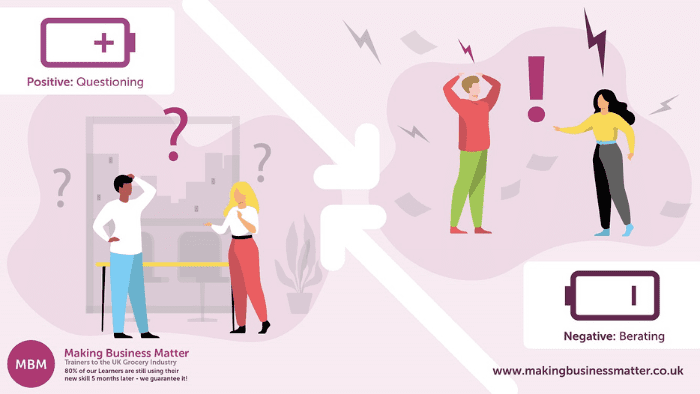
A Positive Push at Work Example – Giving Information
Your project at work is failing and the team has been gathered to re-group and hear from their leader. You could use a pull-style here and ask the team what are their thoughts on the situation and this might be effective.
The more successful style is likely to be push – sharing your thoughts on what has happened and the direction the team should take. As a leader, the team is looking for your opinions based on your extensive experience. The team is looking for assurance and confidence that you know they can succeed.
A Negative Push at Work Example – Vision
A National Account Manager is working on an important presentation for a big client meeting that is happening next week. The NAM proudly brings the draft presentation to his boss, having spent the large part of his week pulling it together. The boss reads through the presentation, and the account manager patiently waits to hope for praise.
After 15-minutes the boss leans back in his big chair and begins sharing his vision of the relationship with the client, how the meeting should go, and some new details that weren’t previously shared about what is required from the meeting. The NAM’s jaw drops. All that work wasted.
Action: The boss should not share vital details, the vision of the relationship with the client, and a vision of the meeting knowing that the NAM was working on the presentation. Better to have pushed the NAM a week earlier and shared.
Click the image below for a higher resolution.

A Positive Push at Home Example – Information Sharing
As my parents are now in their 80’s the inevitable health issues arise. Often a phone call to our house from a parent is about unfortunately one of them not being so well. Imagine the scenario. A phone call comes to the landline – must be a parent – and all you can hear is my wife umming and erring in the right places as one of our parents shares the details of their trip to the hospital.
The rest of us in the family can only wait until it has ended. 45-minutes later, Gayle, my wife, says, ‘I need to share what’s happening about Grampy (Her dad), and shares all that she has just heard and understood. This is push behaviour. Sharing of information, which is one type of push behaviour.
A Negative Push at Home Example – Yet to be Classified!
Every parent has ‘laid the law down at home’ when you believe that your kids are treating your house, their home, like a hotel. Not picking up their washing, not emptying the dishwasher and just turning up for meal times.
Action: I’m afraid that whilst push-pull is a great influencing model, I’m not sure that using push or pull will help solve this!
Click the image below for a higher resolution.
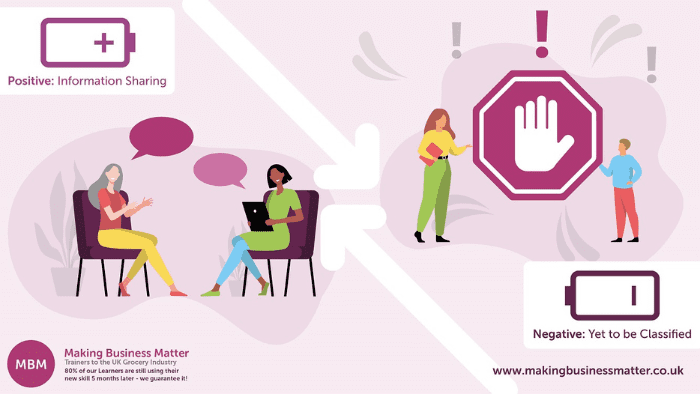
6- This is How Pushers and Pullers Act – Which One are You?
A pushing influencing style displays these behaviours which are split into 4 groups; Selling, Coercion, Logic, and Assertion:
Push Influencing Behaviours
Push: Selling
This group is about communicating the benefits:
- F.B.I.: ‘The Feature of this car is the electric hybrid, which means that the Benefit is less fuel consumption, which gives you the Incentive of a £550 saving per year’.
- HBDI: ‘This laptop has a 13.6-inch screen, a 2.3Ghz processor, 512 ram, and comes with 9 pieces of software, including iMovie’ for free’. This is how we would communicate to a blue of the HBDI profile.
- PSF: Click the image below for a larger resolution.
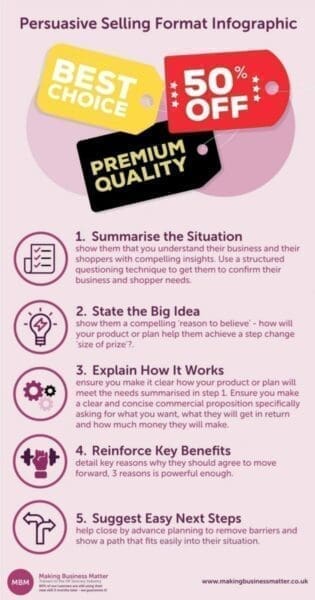
Push: Coercion
This group is about communicating the threats and dangers:
- Personal Dangers: ‘The boss will come down on you like a ton of bricks if you don’t get this project finished soon’.
- Business Dangers: ‘By not paying the GDPR commissioner’s fee, you could be subject to a penalty’.
- Team Threats: ‘If we don’t perform and achieve our targets we could be next for redundancy consideration’.
Push: Logic
This group is about putting forward reasoned discussions:
- Makes Proposals: ‘How about if we met next Thursday at 1pm for 2 hours to sort this project with the team?’.
- States Reasons: ‘I think that we should increase the budget because I have high confidence in the ROI projections’.
- Offers Logic: ‘If we do expand our team and make an additional +100 cold calls per week, we should secure 5 more leads’.
Push: Assertion
This group is about being confident in your beliefs:
- Stating Needs/Wants: ‘I really would like to head up this project, as I have worked on this topic the longest’.
- Saying Evaluations: ‘My review of the leadership team is that we need coaching to see beyond ourselves’.
- Being Persistent: ‘We must continue to find ways to engage prospects through more disruptive marketing’.
Pull Influencing Behaviours
A pulling influencing style displays these behaviours which are split into two groups; Expert, Educative, Building Bridges (Involvement), and Attraction (Emotion):
Pull: Expert
This group is about sharing your expertise:
- Event Speaking: ‘Thank you for inviting me to talk about this favourite topic of mine. Hands up which one of these options on the slide is the part of the topic that most interests you’.
- Forum Sharing: ‘I am an expert in this topic because I have had 4 papers published. What would you like to know?’.
- Work Sharing: ‘In my experience of this subject I can offer 3 options if you would like me to’.
Pull: Educative
This group is about educating people:
- 1. Learners’ Problems: ‘Please tell me a problem that you have around this topic’.
- 2. Learners’ Vision: ‘What does it look and feel like when you have learnt what you need about this topic?’.
- 3. Learners’ Wants: ‘Let me know what you specifically want to learn about this skill’.
Pull: Building Bridges with People (Involvement)
This group is about focusing on the relationship with a person/s. You would like to build a bridge with them because you think that they might have a valid contribution, you are open to being influenced yourself, and the other person will not lose something by working with you.
- Using Recaps: ‘I understand that you have said that there are 3 reasons why you think this deal will fail’.
- Exploring Feelings: ‘How do you feel about next week’s big client meeting?’.
- Self-Disclosure: ‘Last week my team found that leadership conference engaging and inspiring’.
Pull: Attraction (Emotion)
This group is about working with someone that really trusts you and maybe even admires you. They are possibly directionless or unsure and in need of your help, so you want to help them get a sense of purpose, direction, or just some affirmation that what they are doing is right.
- Common ground: ‘We both know and trust John, so that’s a good thing that we have the same opinion’.
- My vision: ‘Let’s build on this vision together of Project 123.’
- Your Direction: ‘Let me help you to create your own profile in this business, starting with – what do you want to achieve?’.
7- Are You a Pusher or a Puller?
Imagine a spectrum with a pusher on the left and a puller on the right. Where are you on that spectrum? To help you concrete the difference between the two in your mind, identify someone at work or in your home life that is a pusher, and now someone that is a puller. Who are you more like? Most people’s reactive answer is that they are ‘in the middle’. You are not.
Click the image below for a higher resolution.
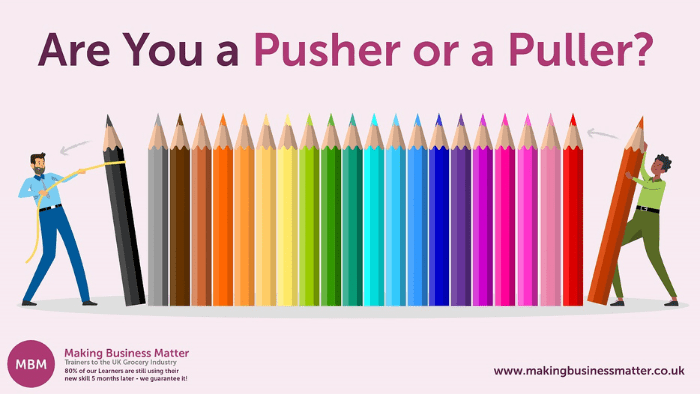
Then they say the clever answer – that they adapt. They don’t. Neither style is right or wrong. It is better to identify where you are.
Once you have identified where you are on the spectrum you can then probably stretch a little across the spectrum. If you are a puller you’ll struggle to be a strong pusher and vice versa, but you can stretch your influencing into the other style to some extent.
How could you develop your influencing style using the push-pull model? Our Influencing Skills Training is a good start. Or our other articles on influencing will help. Or you could identify one thing you could take from the opposite influencing style and start doing it. Maybe it’s to share your opinion more – for pullers, or for pushers, to ask more questions.
8- Selling With a Push or Pull Style
We’ve all met or heard of a ‘pushy salesman’. The type that when you arrive on the car forecourt he talks at you until you either walk away or give in and buy something. This is why it rarely works:
Let’s imagine that I am a father of 3 children and I arrive at the forecourt and stare lovingly at the two-seater red sportscar. The salesman comes over and starts telling me that it has only had one owner, only done 40,000 miles and that it has a full service history. He continues with his patter…
If he had only asked me a few questions about my needs, we could have shared a love for sports cars that we may never own and moved me onto the people carrier (As I have 3 kids) that he has on the forecourt in my price range. The latter could have been a possible sale for him.
This is why marketers often make better salespersons because they ask questions – the pull of the push pull influencing model.
9- In Conclusion…
From the moment I heard of the push pull model many years and have trained people to use it for the last 20 years, I have found it to be one of the most powerful soft skill’s models. This is because of its simplicity. Once you understand that you have always been either pushing or pulling to influence, adding the other side of the coin – push or pull – is like when Anakin Skywalker grabbed a second light sabre.
Push and Pull Influencing Exercises
There are 3 exercises I recommend to improve your influencing skills using this push pull influencing model:
- Firstly, identify where you are on the push pull spectrum. By doing this you can accept that you are either a pusher or a puller. Then you can move on to adapting yourself to include the other style, when appropriate.
- Share what you have learnt about this model with your boss, and ask for feedback. The feedback should be specific and these questions will help:
- Where do you think I am on the spectrum?
- Please rate my ability to do <push/pull> (select one), and why do you rate me at that level?
- How do you think I should begin adopting the other style?
- Identify a situation that is coming up where you can use the other style to your default. Use the information in the article above to prepare yourself to influence in the other style.
Click on the image below for the high resolution infographic:
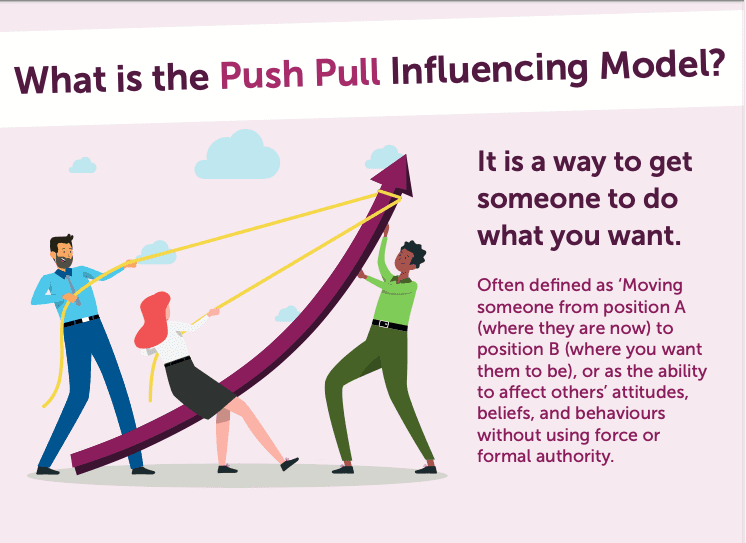
Happy influencing!




